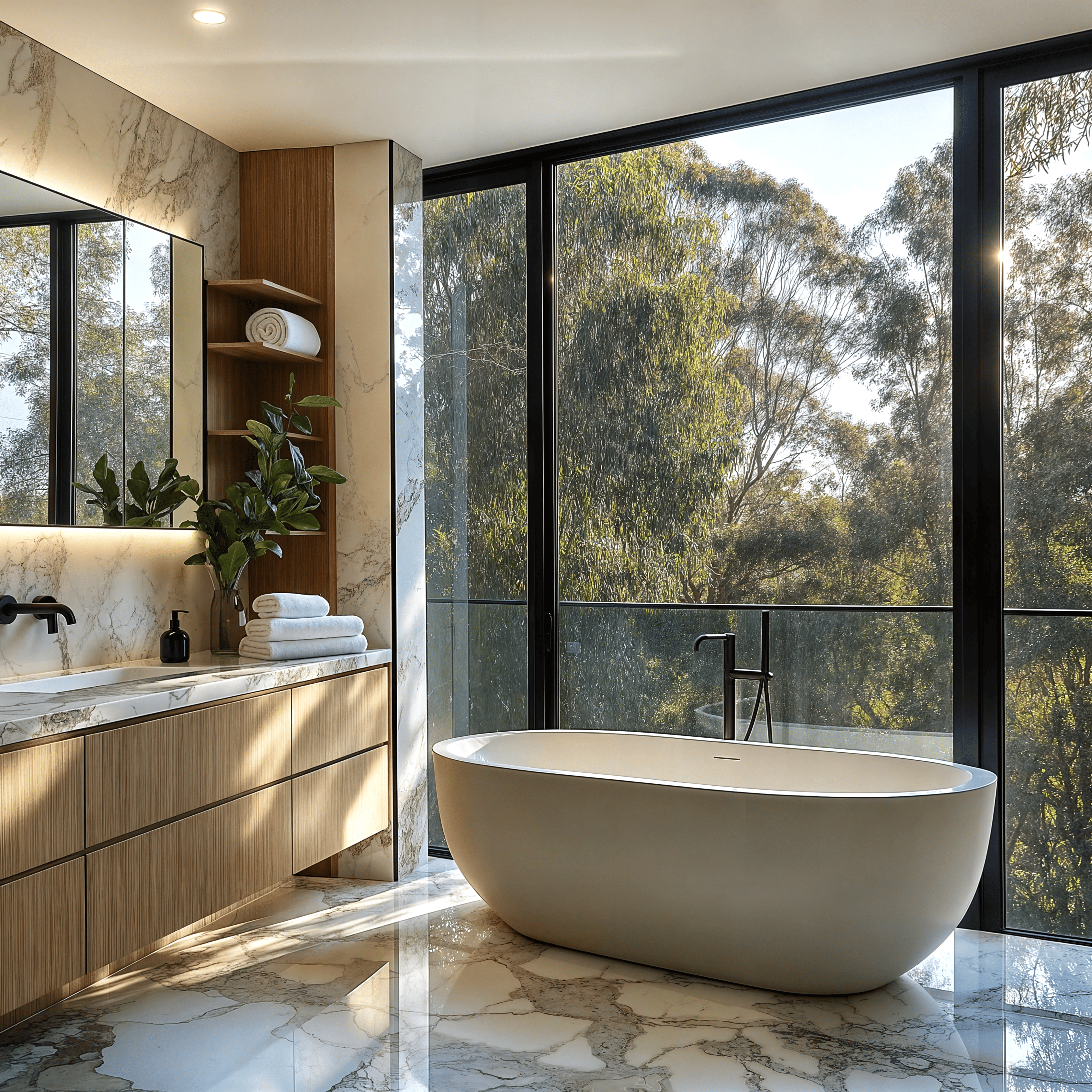Do it smart: Plan ahead to ensure a successful bathroom renovation
Homeowners should be mindful of unexpected costs when renovating their bathrooms. To stay ahead, it’s essential to plan proactively and account for potential expenses in your renovation budget. This is why having a well-thought-out contingency plan is a crucial part of the overall budgeting process. However, even the best-laid plans can be thrown off by hidden costs that often arise during renovations. By understanding these potential expenses, you can better prepare for the unexpected and ensure your project stays within budget.
Here are the top 5 most common unexpected costs associated with bathroom renovations:
1. Plumbing Costs
When renovating a bathroom, the plumbing behind your walls and under your floors might not be as simple as it seems. Many homeowners don’t realise that their existing plumbing may need to be updated to accommodate modern fixtures or meet current building codes. For example, if your home is older, the pipes might be corroded, too narrow, or made of outdated materials that aren’t compatible with new bathroom features like rain shower heads or water-efficient fixtures.
This becomes a hidden cost because these issues often only come to light once the renovation begins, and contractors start working on the plumbing. Replacing or upgrading pipes, valves, or drainage systems can quickly add to your expenses. Even if your plumbing seems fine at first glance, some systems may require adjustments to handle the increased water flow or to prevent leaks and water pressure issues.
To prepare for this, homeowners should budget anywhere from $1,000 to $5,000 for plumbing upgrades, depending on the extent of the work and the age of your home. Setting aside a contingency fund for unexpected plumbing needs ensures you won’t face unwelcome surprises halfway through your renovation.
2. Waterproofing Costs
Waterproofing is a critical part of any bathroom renovation, but it’s often an area where unexpected costs can arise. Most homeowners don’t think about what’s beneath their tiles or behind their walls, but these unseen areas must be properly sealed to prevent water from seeping through. If moisture isn’t contained, it can lead to serious problems like mold growth, rotting structures, or water leaks into other parts of your home.
The hidden cost here is that waterproofing issues are sometimes only discovered during the renovation process. For instance, if your previous bathroom was improperly waterproofed or has suffered from long-term water damage, the existing substrate (such as timber or plasterboard) may need to be repaired or replaced before new waterproofing can be applied. Additionally, waterproofing must meet strict building standards, so any shortcuts or outdated materials from previous renovations might require costly corrections.
To prepare for this, homeowners should budget $500 to $2,500 for waterproofing alone, depending on the size of the bathroom and the extent of any damage. If structural repairs are needed due to water damage, costs can climb higher. Investing in proper waterproofing is essential to avoid long-term problems and expensive repairs down the road. A well-sealed bathroom ensures durability and peace of mind for years to come.
3. Structural Fixes
Structural fixes can become a significant hidden cost during bathroom renovations because they address the very framework that supports your bathroom. Unlike waterproofing, which deals with moisture containment, structural fixes involve repairing or reinforcing the physical components like floor joists, wall studs, or even the foundation itself.
For example, when you remove old tiles or a bathtub, you might discover that the subfloor has sagged due to years of weight or water exposure. In some cases, poorly constructed or outdated materials may no longer be strong enough to support modern fixtures like freestanding tubs or larger vanities. Similarly, if walls need to be moved or adjusted for your renovation, contractors might find that the framing isn’t up to code or requires additional support.
Structural fixes are often unexpected because these issues are hidden beneath layers of flooring, walls, or tiles. You wouldn’t know that the floor beneath your shower is compromised or that a load-bearing wall was improperly built until the renovation process exposes these weaknesses.
Homeowners should budget $2,000 to $6,000 for structural repairs, depending on the scope of work and the age of the home. These costs can vary significantly based on whether minor reinforcements are needed or if more extensive repairs, like replacing rotted subfloors or shoring up load-bearing walls, are required.
4. Electrical Costs
Electrical work is often overlooked in bathroom renovations, but it can quickly add unexpected costs to your project. Bathrooms require specific electrical setups to safely power lighting, outlets, and appliances, especially in areas prone to high humidity. For example, new fixtures like heated towel rails, underfloor heating, or smart mirrors might need additional wiring, upgraded circuits, or new safety switches to function correctly and meet current electrical codes.
This becomes an added cost because older homes may not have sufficient wiring or breaker capacity to handle the demands of modern bathroom features. For instance, installing a new vanity light might reveal outdated wiring that needs to be replaced, or adding a smart toilet could require a new dedicated circuit. These issues often arise during the renovation when electricians begin their work and assess the existing system.
To prepare for these potential expenses, homeowners should budget $500 to $3,000, depending on the complexity of the electrical upgrades and the number of fixtures being added or replaced. Electrical work is essential for safety and functionality, so ensuring it’s done correctly not only enhances your bathroom’s usability but also protects your home from risks like electrical fires or short circuits.
5. Customisation and Bespoke Bathroom Fixtures
Opting for bespoke or custom bathroom fixtures, like marble sinks or handcrafted vanities, adds a layer of personalisation and luxury to your bathroom. These high-end options come with higher costs that homeowners may not initially anticipate. For instance, custom vanities might require precise measurements and specialised installation, increasing both production and labor costs. Similarly, materials like marble or natural stone can be significantly more expensive than standard options and often require professional sealing and maintenance.
Additionally, lead times for bespoke items can be longer than standard fixtures, potentially delaying your renovation timeline and incurring extra labor costs if contractors need to wait for deliveries. To prepare for these expenses, homeowners should research the costs of bespoke items early in the planning phase and factor in an additional 15-30% of the fixture cost for customisation and installation.
Renovating a bathroom is an exciting journey, but it’s essential to plan for hidden costs to avoid unexpected surprises along the way. Partnering with the right tradies is crucial– they can identify potential issues early, provide quality workmanship, and ensure that your renovation stays on track and within budget. Clear communication and working with experienced professionals can make all the difference.
Equally important is choosing the right bathroom retailers for your fixtures and finishes. At Austpek, we take pride in delivering bespoke and custom bathroom fixtures tailored to your unique style. With our commitment to quality and efficiency, we ensure your fixtures are delivered on time. Whether you’re looking for premium vanities, luxury bathtubs, or other high-end fixtures, we’re here to bring your vision to life while making the process seamless.








